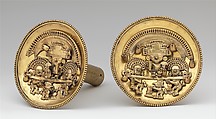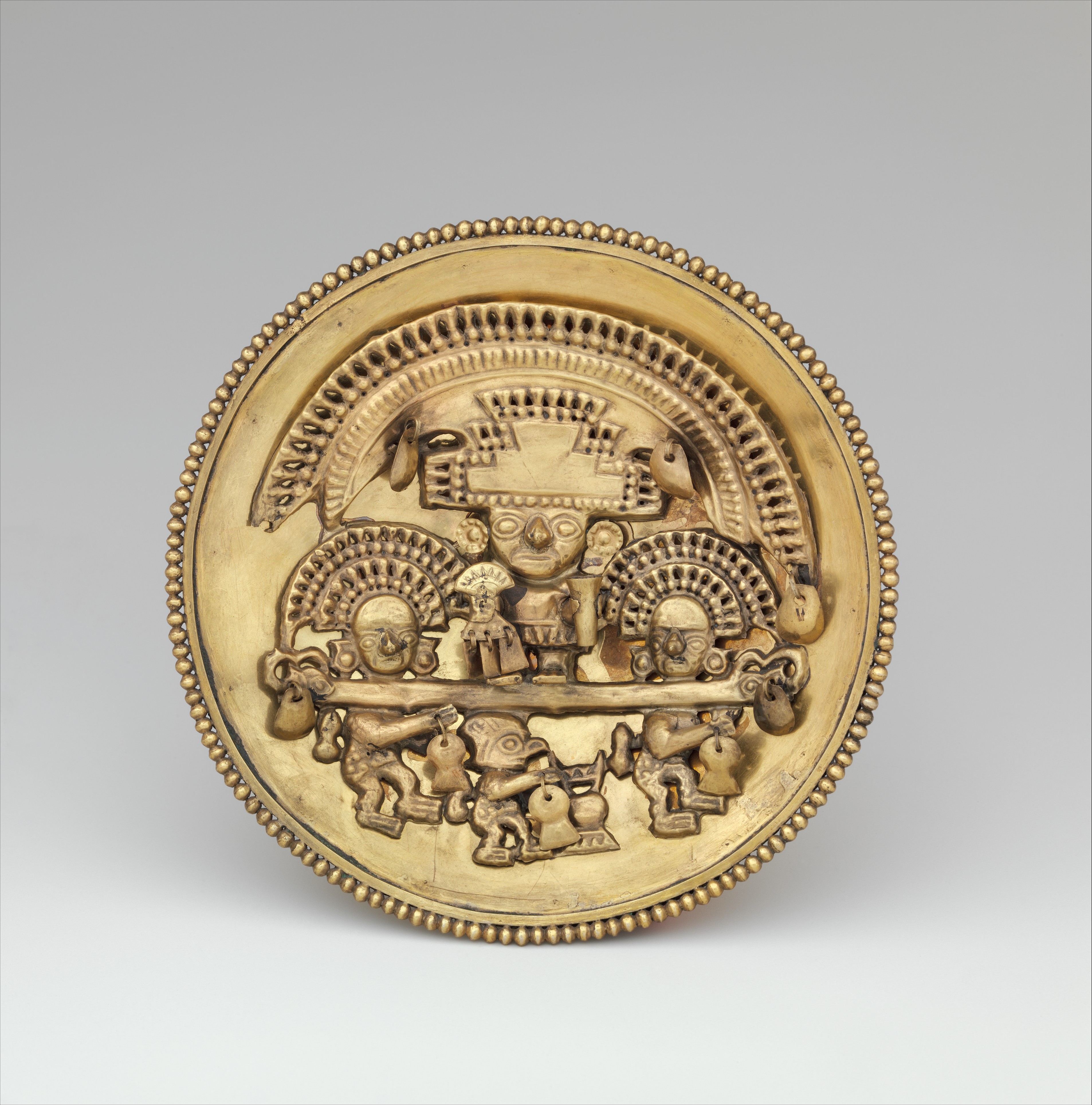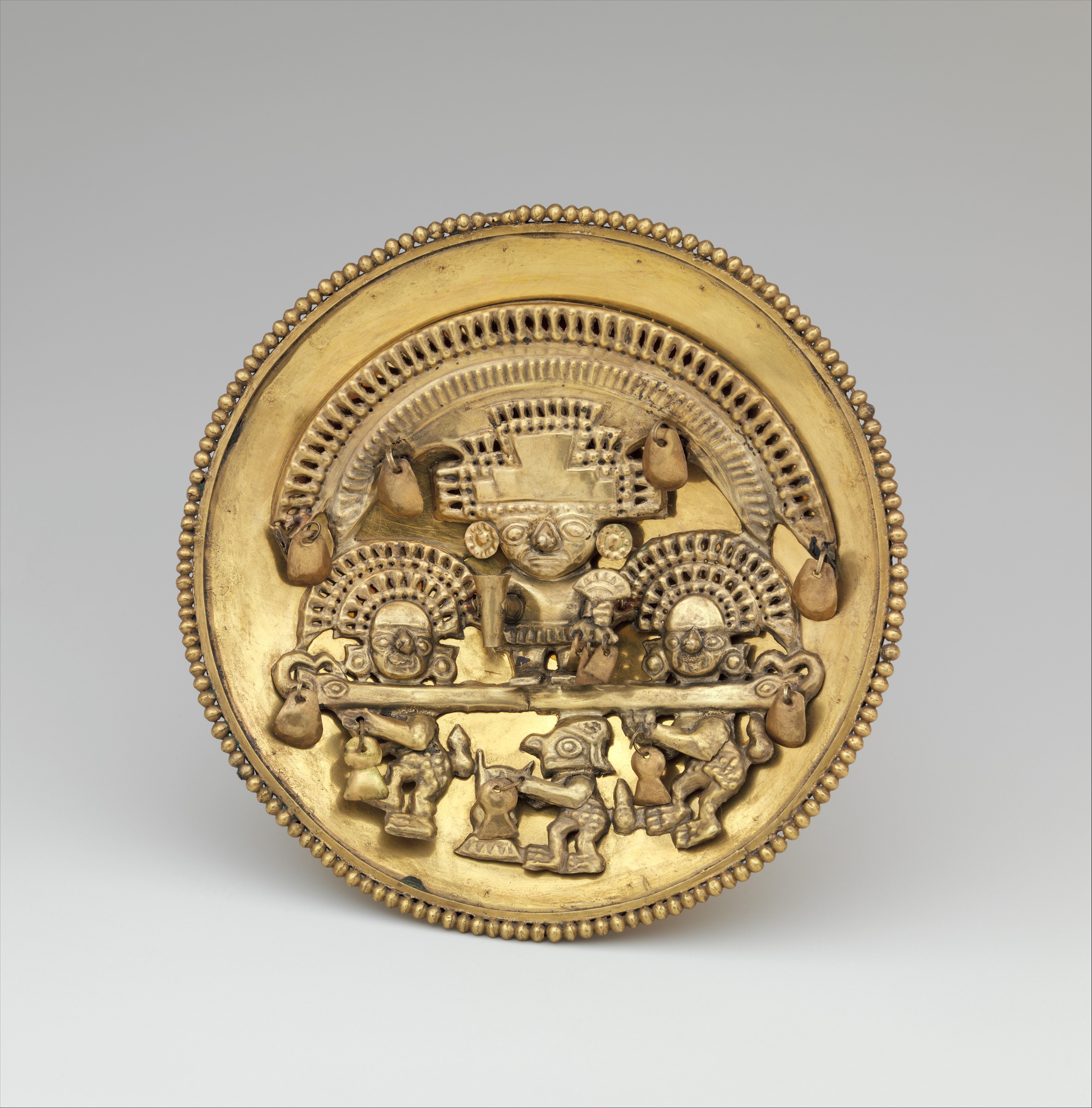Pair of Earflares with Multifigure Scenes
Not on view
Ear ornaments were an important component of courtly regalia in the ancient Andes from at least the first millennium B.C. to the arrival of the Spaniards in the sixteenth century. Some of the most spectacular examples in the late pre-Hispanic period were made at Chan Chan, capital of the Chimú Empire, in the Moche Valley on Peru’s North Coast. This pair of earspools features nearly the same composition on each ornament. The principal figure, likely a depiction of political leader known as a cacique or lord in sixteenth-century Spanish texts, wears a large crescent headdress and stands on a litter (a type of conveyance used to carry an individual, or individuals), born aloft by two smaller-scale figures with similar, but smaller headdresses. The lord himself wears large round ear ornaments that have a central boss and decorated borders. His tunic—the primary male garment in the late prehispanic Andes, worn over a loincloth—is embellished with a fringe or patterned border. He holds a beaker in one hand and a fan in the other. A fourth figure, still smaller in scale, is shown below the litter, immediately underneath the lord.
The lord’s complex headdress consists of a stepped element surmounted by an impressive, two-tiered crest representing feathers, echoing the crescent-shaped fan in his hand, which was also likely composed of feathers. A similar headdress was found archaeologically at Chan Chan in the early twentieth century, and the type has also been depicted on other works in metal, such as a beaker now in the collections of the Denver Art Museum (accession number 1969.303; see Pillsbury, Potts, and Richter 2017, cat. no. 57). All of the components of the lord’s representation—his larger scale and central position on a litter, but also the regalia he wears and carries—speak to his power and importance. Litters and beakers were closely associated with leadership on the North Coast (see, for example, MMA 1991.419.62; 1991.419.61). The use of a litter--rendered here as a simple bar, representing a platform, terminating in an animal head at each end—was restricted to those at the very top of the political hierarchy, and vessels made of precious metals were at the heart of rituals designed to invoke divine powers and bind communities together. Sixteenth-century sources document the bitter outcry from local lords when Spanish authorities revoked these privileges in the colonial period.
On one earspool (MMA 1991.419.68), the lord holds the beaker in his right hand and the fan in his left; on its mate (MMA 1991.419.67), the lord holds the beaker in his left hand and the fan in his right. On MMA 1991.419.68, the attending figures are moving to the lord’s right (the viewer’s left); on its mate, they move to the lord’s left. Following a convention established in Moche times (A.D. 200–850), figures on earspools face inward, therefore it is likely that when this pair of earspools was worn, the litter bearers were. marching toward the wearer.
The two figures who hold the litter are shown with frontal faces and bodies in profile. These bearers have ear ornaments characteristic of the Lambayeque region, farther to the north (see, for example, MMA 1974.271.60). Other details also reveal a connection to that region: the figure attired in a simple loincloth and wearing a plain head-cloth, shown below the litter, carries a double-spout-and-bridge bottle—a type of vessel closely associated with Lambayeque. The Chimú conquered this region in the fourteenth century and incorporated many of their traditions—and likely many of their metalsmiths—into their court at Chan Chan.
These complex ear ornaments were created from gold sheet that was cut and embossed; stapling and soldering joined the pieces. Tiny hollow spheres, also made of sheet metal, encircle the concave disks. Despite their considerable size, the earspools are remarkably lightweight. The large hollow shafts—the part that would have been inserted through the earlobes—were chased with a diamond-pattern design of crested birds and soldered to the backs of the frontals. Multiple danglers secured to the cutout forms on the front would have moved when the ornaments were worn, catching the light in a dazzling display of wealth and power.
A similar pair of earspools now in the Minneapolis Institute of Art (accession number 43.4.1) features a monkey in the place of the subsidiary figure below the litter.
Joanne Pillsbury, Andrall E. Pearson Curator, Arts of the Ancient Americas, 2018
References and Further Reading
Carcedo Muro de Mufarech, Paloma, and Izumi Shimada. “Behind the Golden Mask: Sicán Gold Artifacts from Batán Grande, Peru.” In The Art of Precolumbian Gold: The Jan Mitchell Collection, edited by Julie Jones, pp. 60–75. New York: The Metropolitan Museum of Art, 1985.
Elera, Carlos G. “The Face Behind the Mask.” In Peru: Kingdoms of the Sun and the Moon, edited by Victor Pimentel, pp. 96–107. Montreal: Montreal Museum of Fine Arts, 2013.
Jones, Julie. The Art of Precolumbian Gold: The Jan Mitchell Collection. New York: The Metropolitan Museum of Art, 1985.
Jones, Julie, and Heidi King. 2002. “Gold of the Americas.” The Metropolitan Museum of Art Bulletin 59 (4): 1–59.
Mackey, Carol J., and Joanne Pillsbury. “Cosmology and Ritual on a Lambayeque Beaker.” In Art of the Pre-Columbian World: Honoring the Contributions of Frederick R. Mayer, Margaret Young-Sánchez, ed., pp. 115-141. Denver: Denver Art Museum, 2013.
Moore Jerry D., and Carol J. Mackey. “The Chimú Empire.” In The Handbook of South American Archaeology, Helaine Silverman and William H. Isbell, eds., pp. 783-807. New York: Springer, New York, 2008.
Pillsbury, Joanne. “Imperial Radiance: Luxury Arts of the Incas and their Predecessors.” In Golden Kingdoms: Luxury Arts in the Ancient Americas, edited by Joanne Pillsbury, Timothy F. Potts, and Kim Richter, pp. 33-43. Los Angeles: The J. Paul Getty Museum, 2017.
Pillsbury, Joanne, Timothy Potts, and Kim N. Richter, eds. Golden Kingdoms: Luxury Arts in the Ancient Americas. Los Angeles: J. Paul Getty Museum, 2017.
Shimada, Izumi. “The Late Prehispanic Coastal States.” In The Inca World, edited by Laura L. Minelli, pp. 49–110. Norman: University of Oklahoma Press, 2000.
Wester La Torre, Carlos. Chornancap: Palacio de una gobernante y sacerdotisa de la cultura Lambayeque. Chiclayo: Ministerio de Cultura del Perú, 2016.
Due to rights restrictions, this image cannot be enlarged, viewed at full screen, or downloaded.
This artwork is meant to be viewed from right to left. Scroll left to view more.




